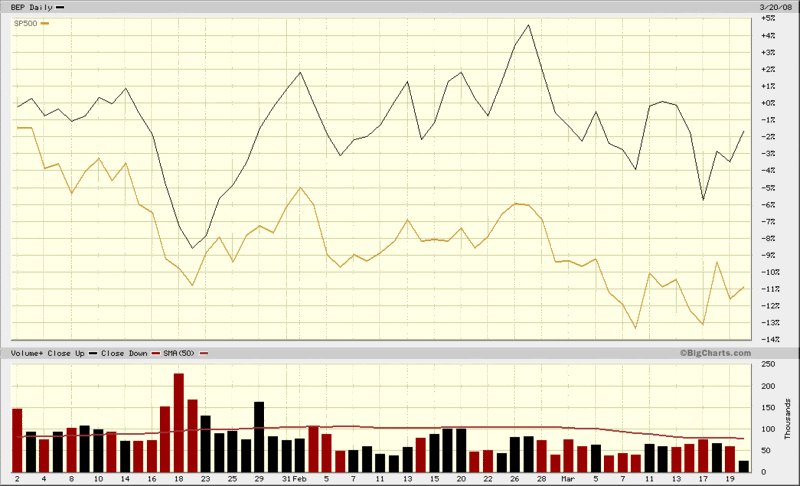BEP and the Joy of Covered Call Funds
I have spoken about buy-write or covered call funds on a number of occasions, perhaps most notably in One Approach for Volatile Sideways Markets.
One of my favorite funds in the covered call space is the S&P 500 Covered Call Fund (BEP), a closed-end fund that is the most actively traded of the covered call funds. BEP is currently trading at a 4.9% discount to net asset value and is an excellent way to capture some of the volatility premium in the current market without having to go to the trouble of establishing your own covered call portfolio. Looking at the chart below, while the SPX is down approximately 11% year to date, by writing covered calls against the SPX, BEP has managed a loss of only about 1.5% since the beginning of the year. Covered call funds will almost always outperform the SPX in down and sideways markets, but will generally have less upside potential in a bull market.
For a more detailed profile of BEP, follow the link to the Closed-End Fund Association’s (CEFA) web site or get an annual report and other information directly from the BEP splash page at IQ Investment Advisors.



3 comments:
There was an interesting article on TickerSense stating that the uptick rule change last summer may have been responsible for the VIX rising to current levels. If the rule change did in fact make a fundamental change in how the VIX operates, then perhaps the current VIX levels are more "normal" and won't necessarily drop back to pre-summer 07 levels.
Any comments?
Thanks,
Marc
Marc,
the VIX reflects the market expectation of S&P 500 volatility over the next 30 calendar days, calculated by a set of S&P 500 index options (calls and puts) with an average maturity of 30 days.
I don't see any connection between the omission of the uptick rule and the increasing VIX (by all means the omission of the uptick rule did NOT make any fundamental changes in how the VIX is calculated).
Even Jim Cramer who is currently launching a campaign to reinstate the uptick rule (http://en.wikipedia.org/wiki/Uptick_rule) does not blame the omission of the uptick rule to be responsible for the increasing volatility, but instead requests to reinstate the uptick rule to slow down the pace of short sellers.
In fact implied volatility is regularly trading with a premium on realized volatility (there is a hedge fund strategy called volatility arbitrage, selling implied volatility and hedging by buying realized volatility).
On July 13, 2007, the annualized rolling 1-month (22 trading days = 30 calendar days) variance has been 175.86 (=13.26%), the VIX has been 15.15(%). It was only logical that the market expected an (only small amount in) increasing volatility because the VIX was trading at historical low levels (as was the realized variance).
On March 19, 2008, the annualized 1-month (22 trading days = 30 calendar days) variance has been 809.56 (=28.45%), the VIX has been 26.62(%). So currently the VIX is trading at a (small) discount to the annualized rolling 1-month (22 trading days = 30 calendar days) variance, reflecting the market's expectation of a decreasing variance/volatility during the next 30 calendar days.
If we are not at extreme values (e.g. VIX above 40), there is almost always a correlation (but not a perfect one) between realized variance (history) and the value of the VIX (forecast of future volatility), because reversion to the mean (in volatility) is normally a steady process and not something jumping back and forth within 1 calendar month.
So obviously the VIX is first of all correlated to the currently realized rolling and annualized 1-month variance (mean reversion is a steady process) and secondly reflects the market's expectation of the future direction of volatility (so the VIX is either trading with a premium or discount -regularly a small one- to the then realized 1-month variance).
If we'll see a (long) period with a very low annualized 1-month (22 trading days = 30 calendar days) variance, we may see the VIX drop back to pre-summer '07 levels again (but my personnel opinion is that this will take a very long time).
Best regards
Frank
Hi Marc and Frank.
First off, Frank always brings some serious analysis to the table and I agree with the gist of his comments here.
Some have argued, however, that the elimination of the uptick rule may have made it easier to short individual stocks, perhaps indirectly making it easier for the markets to fall and for volatility to increase. While the elimination of the uptick rule may have had a very small impact on shorting and volatility, I maintain that most institutional shorting has been done via indices, ETFs, puts and futures -- activities which were only marginally affected (if at all) but the elimination of the uptick rule.
Personally, I think that inverse ETFs and increasing volume/liquidity in ETF options has had more of an effect on the VIX than the uptick rule.
See my posts of Feb 19 and Feb 22 for more details on my thinking.
Cheers,
-Bill
Post a Comment